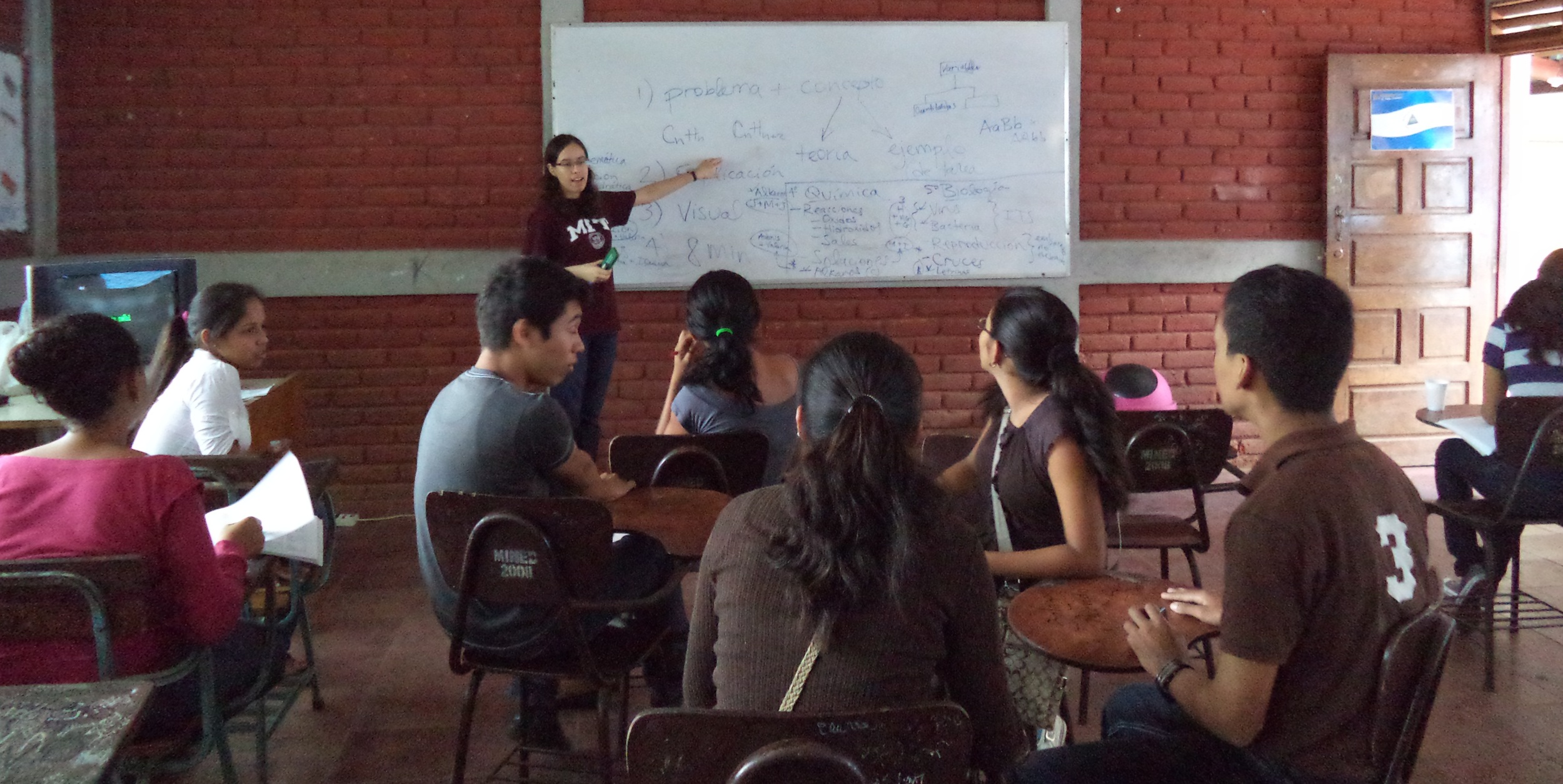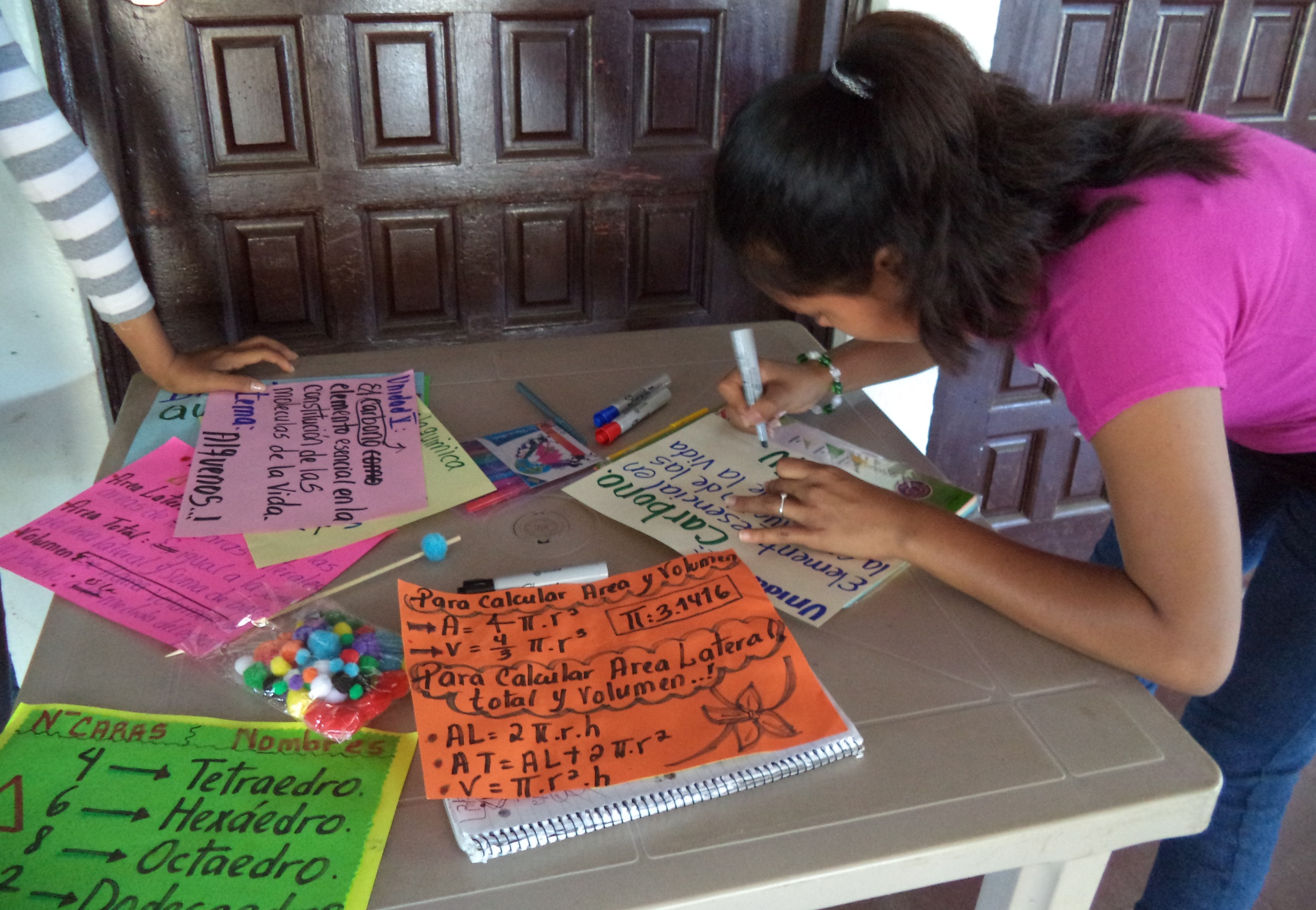Sofia Essayan-Perez (Massachusetts Institute of Technology) works to strengthen math and science education in rural high schools in Nicaragua. Building on years of collaboration with healthcare providers, teachers, administrators, and students, she helps to create lesson plans grounded in local issues. Sofia also teaches students to create educational videos, thereby developing low-cost resources while integrating technology in the classroom. Her goal is to promote peer-to-peer instruction, improve teacher training, as well as improve math and science understanding.
Entry 1 - "Land of Lakes and Volcanoes"
Entry 1 – “Land of Lakes and Volcanoes”
I always look forward to arriving in Managua, Nicaragua, as it marks a new chapter in my fieldwork with the community of Diria, a rural village in the southwestern part of the country that is 90 minutes from the capital. This IAP 2014 I am working again with students and teachers in the two local high schools in this rural zone.
Arrival
After six hours in the air, the rough landing provided beautiful views of two of the many volcanoes in Nicaragua:
© Sofia Essayan-Perez
Context
Nicaragua is the second poorest nation in the Western hemisphere (after Haiti). About half of the country falls below the national poverty line.(1) In addition, 43% of the population lives in rural areas, and the majority are below the poverty line.(2) In Diria, where I will be working this IAP month, most families live under $2 USD a day.
Education
Nicaragua has had several literacy campaigns and has free primary and secondary education. 78% of the population over 15 years old is literate.(2) However, many students drop out of primary school and even fewer make it to the end of high school. Of primary school-aged children, 93% of males and 95% of females enroll, yet 56% actually complete all primary school years.(3) Of high school-aged youth, 43% of boys and 49% of women enroll, yet attendance drops to 35% and 47% respectively.(3) In my years of work with rural high schools, I have noticed that many boys drop out of high school to work in agriculture or in manual labor to help gain income for their families. Also, I have met girls who are taken out of school to care for their younger siblings.
Employment
From the Managua airport, I travelled to Diria. The 90-minute trip says a lot about the employment situation, as well as relative poverty levels between urban and rural zones.
In Managua, many people work in the informal sector. The hustle-and-bustle of the markets along the road demonstrates how vendors are drawn to the urban areas to sell their crops for higher prices. They carry woven baskets filled with fruits and vegetables and ride the bus to the city with their goods.
© Sofia Essayan-Perez
40 minutes away from Managua, the free trade zones (FTZ) offer a regular salary and benefits. It is common for Diria’s inhabitants to work in FTZs. Each day, they commute halfway to the capital. FTZs are placed in areas that used to be for agriculture; notice how this FTZ building is right next to farm lands.
© Sofia Essayan-Perez
70 minutes from Managua, one begins to see more farms. The majority of Nicaragua’s crops are beans, corn, and coffee. Most homes on the farms are made of tin and wood, as in this image.
© Sofia Essayan-Perez
These images show the large difference in the employment and infrastructure found in urban and rural areas. Many Diria villagers equate the capital with better living conditions, as Managua has universities, higher-paying jobs, and cultural activities. This causes a local “brain drain”. Additionally, since I first began to work in Diria, I have seen many high school students move seasonally with their families to Costa Rica, to work in the farms or in construction. What’s even more common is for one or both of their parents to move, leaving the children behind with relatives. Many of the students I work with spend their vacations in northern Nicaragua, in the coffee growing regions, picking coffee, or in Costa Rica, working as fruit-pickers to earn more income for their families.
Overview: High Schools in Diria
Diria is a rural municipality that includes the village center and Palo Quemado, a farming community 30 minutes away on unpaved roads. Diria has two public high schools with 500 high school students. The teachers and students have few books and materials. Until recently, their microscope was a hand-drawn picture of one, posted on the wall. High school in Nicaragua runs from grade 7 through 11. Given the limited number of classrooms, students in grades 7 through 9 attend a morning shift, while students in grades 10 and 11 attend an afternoon shift.
Ongoing Projects
Diria’s high school graduates face a significant obstacle when seeking university admission: passing the national math entrance exam. In 2012 and 2013, only 4% of public high school graduates nationwide passed this exam. I noticed that many of the students in Diria were unable to pursue professional careers due to their difficulty in math, and decided to help strengthen math teaching. My meetings with students, teachers, administrators, parents of students, and alumni further confirmed that math was the prevalent weakness in grades 7 through 11.
During IAP 2012 and 2013, I partnered with both high schools in Diria to work on two initiatives. First, we created interactive lesson plans to complement the current Nicaraguan high school curriculum. These lesson plans help them teach math and science in a way that is relevant for students, by connecting concepts to local economic activities and health issues. Second, I have taught local students to make educational videos for math and chemistry. This allows students to use technology as a means of mastering the material, and helps teachers use new, low-cost resources to teach the rest of the class. My aim is for students to become more engaged in science and math, so they will perform better on their university entrance exams, enabling them to study fields in the sciences that are important for Nicaragua’s development.
Goals for This Trip:
In previous years, I worked on math. This IAP, I am expanding the initiatives to chemistry. These are the areas I will be working on:
1. Creating chemistry lesson plans and lab experiments
2. Teaching students to make educational videos in chemistry and math
3. Initiating a website to host the lesson plans and videos
References:
(2) http://www.ruralpovertyportal.org/en/country/statistics/tags/nicaragua
(3) http://www.unicef.org/infobycountry/nicaragua_statistics.html
Entry 2 - Community Voice: Valeria
Entry 2 – Community Voice: Valeria
One of the students, Valeria, has been very involved this year and last. Here, she shares her perspective on the educational video-making process:
My name is Valeria, and I am entering grade 11. I have made educational videos for mathematics and chemistry. In mathematics, I have focused on the “Pythagorean theorem” and “systems of equations”. In chemistry, my videos address “alkane nomenclature” and “chemical solutions”.
In an ordinary math class, our teacher first starts out by asking us sample questions related to the topic. He then lectures, and we write down what he says. After, he teaches us how to solve problems related to the concept, and asks us to go to the board to solve examples.
In our usual chemistry classes, the teacher begins by asking us questions related to the concept, then dictates the key points, and also uses examples. For instance, for alkane chemistry, she would explain the concept and then write a sample problem on the board. If we understood the topic, she would move on; otherwise, she would provide us with more examples.
Whenever our videos are shown in the classroom, my peers become more interested, pay attention, and are silent. The teachers usually ask us at the end of the video if we enjoyed it, and students always answer “yes” because they benefitted from the review of a concept that we had just learned. I have noticed that, when they are asked about the concept in the video at a later time, they still remember the information. My peers have also liked how the videos do not include their faces, so the focus is just on the material. The videos are dynamic, and it’s remarkable how silent the students are when watching them.
Mainly, my teachers use the educational videos to reinforce concepts that they have taught. My classmates enjoy this, and have asked that we continue to make videos. I enjoy this because we feel satisfied of our work. Once, our math teacher was sick, and we did not know how to solve an exercise problem. We asked another teacher to set up a video we had made on the corresponding topic; after we watched the video, we discovered what we needed to solve the problem. By using the videos, we were able to come up with a solution.
My teachers usually decide when to make a video, based on what the class has difficulty with. My chemistry teacher, for example, asked my classmate, Jose, and me to help with one on chemical solutions. She guided us through the process, particularly because it had been a while since I had made a video, and another teacher helped with the filming process. In another instance, my classmates were struggling with a topic, and we reminded our teacher that we had a video we could use. After we saw the video, we were able to solve the exercises and understand the concept better.
For students making the videos, we are reviewing concepts that were difficult to us. I chose topics that I had the most trouble with; as I am a good student, I wanted to reinforce topics to understand them better. Sometimes, my classmates understand a concept that I do not, so I want to learn these topics better. Aside from learning a concept well, I am able to help my classmates so that they too can achieve high grades. This is what I like about making educational videos.
In this process, I have learned many ways to support my classmates, and this has humbled me, as I look for ways to help others. The videos are important because students at my high school gain confidence in their knowledge, and through these videos they learn more than what they knew before watching them. The fact that my peers are learning is what makes these videos most important to me.
Entry 3 - Video-Making
Entry 3 – Video-Making
I am working with high school students in Diria to create educational videos for chemistry and math classes.
Students planning their educational videos. © Sofia Essayan-Perez
Our group creating videos this year. © Sofia Essayan-Perez
Presenting initial ideas and receiving feedback from peers. © Sofia Essayan-Perez
Preparing visual materials to include in the videos. © Sofia Essayan-Perez








